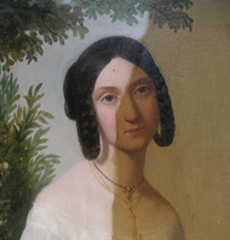Katja Gibson
Painting Restoration

| "Art has no enemy except ignorance" -Latin Proverb |
|
Common procedures |
|
Cleaning – The most common issues with a painting are either old yellowed varnish or the accumulation of dirt and grime on the surface. Most of the time, both can be removed safely. Tears, Punctures – Small tears and punctures are mended by patching or by careful gluing of the fibers back together with added the reinforcement of new threads. The missing paint is in-filled with gesso and in-painted with pigments dissolved in Acryloid B-72. Lining and Striplining – If the stability of a painting has been compromised (by a large tear, for example) a new support is needed to hold the painting together. The original painting is attached to a new piece of fabric using an appropriate choice of adhesive. This process is performed on a vacuum hot table. In some cases, the tacking edges of a painting are too weak and fragile to bear the tension of stretching, and here thin strips of new canvas are glued around the sides of the painting as a reinforcement. Removal of old lining – Unfortunately, many paintings have been lined in the past simply for profit but not for necessity. The reversal of lining is usually possible. The removal of a very old and/or failed lining is also performed; in this case the next step is to line the painting anew properly. In-filling and In-painting – Areas of missing, flaked-off paint are in-filled with gesso first, "texturized" to match the thread pattern of the adjacent area and then in-painted carefully with pigments dissolved in Acryloid B-72. Humidity Treatment and Paint Stabilization – Excessive humidity, improper storage, or extreme temperature fluctuations can cause serious damage to a painting. The canvas stretches and contracts, the paint layer cracks, lifts and flakes off. The canvas sags and becomes loose or bulges. In most cases, a proper humidity treatment will bring a painting back to plane. Flaking paint can be successfully stabilized and carefully re-adhered. Varnishing – Varnish, like a good sunscreen, protects a painting from the environment, especially pollution and dust. It should be fully removable and applied correctly to bring a painting to life. |